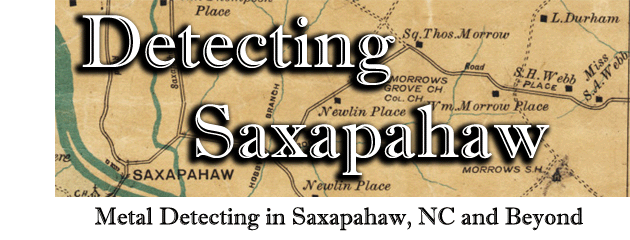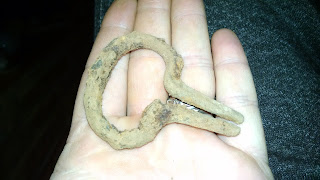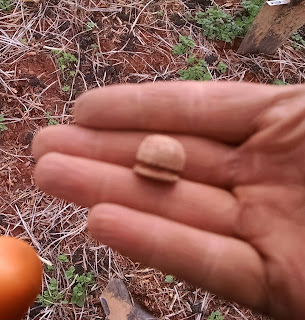I left off the end of day one with a promising sign - two bullets and a button from the same hole. The earth was loose, and darker than the surrounding red clay with flecks of black charcoal within. I had found some sort of hut or firebox from the winter of 1863. Needless to say, I was anxious to get back in there on day two.
I would like to give a huge shout out and thank you to my good friend Tracy, who sacrificed much of his own hunting time to help dig out what turned into a pretty good sized hole. We had a blast, laughing and carrying on the whole time. Thanks again, buddy. Jimmy, Keith, Jewel, and Debbie were never far away, and if was wonderful getting to share this experience with my friends. Here's Tracy digging while Jimmy supervises, and I stand in the way!
We started off simply chasing the metal targets, excavating carefully as we went to look out for possible non-metal targets. By the end of the dig, we had recovered nine bullets from the time capsule, including two 54 caliber bullets and one tiny percussion cap. We also saved four buttons - one iron underwear button in really remarkable shape, two eagle coat buttons, and one cuff button from the state of New York.
The remainder of the brass targets in the hole were these small brass grommets. They may not seem like much, but they are actually a fascinating little piece of Civil War history. These small brass circles most likely came from a soldier's gum rubber blanket. These rubberized blankets, or rubberized ponchos for the cavalry, provided just a little of the much needed protection from the wet ground. Staying dry was so important in these cold and often unsanitary winter camps.
Col. Holoman Melcher makes note of these pieces in a letter home from the 20th Maine. He writes. - "We are encamped here near the Potomac with the rest of Porter's Corps. Encamped, I say, though we have not been in a tent since we left Portland. But we substituted our rubber blankets. Two of us tie them together, they being provided with eyelet holes, then draw them over a frame, they make a tent high enough to sit up in but not to stand, and with straw on the ground and our woolen blankets we get along very well."
Shown above is a quartermaster photo showing the rubberized poncho. Below is an original gum rubber blanket identified to the 16th New Hampshire Volunteers, shown by its current owner Tristan G. on a Civil War collectors page.
While following metal targets, we were constantly on the lookout for fragments of glass, bone, or other non metallic objects in the side wall and spoil piles. The most unique non metal artifact found is just a fragment - and quite frankly I'm amazed any of it survived! This is a small piece of leather, with the original stitching holes still visible. I believe it to be the bottom of a soldier's shoe, although with so little of it remaining it's hard to say for certain.

In one corner of the hole, we discovered a collection of very large rocks - most likely from the fireplace of the hut. These rocks very nearly destroyed some of the best finds from the hut, but in all likelihood also spared them from being struck by a deep plow. It is quite miraculous that they were able to survive. After rolling one of these large fireplace stones out of the way, the side wall of the hut fell away to reveal the neck and shoulder of a glass bottle. Slowly and carefully, the bottle was excavated from the rocks, and in the process a second bottle started to show behind it.
When all was said and done, I had excavated two nearly perfect Civil War whiskey bottles. To say I was happy would be an understatement!! This was the find of the week for me, without a doubt. Liquor played an important role in the war, both for morale and medicinal uses. A tax on whiskey, like the two bottles I'm holding below, was instituted in 1861 to help fund the war effort.
The final artifact to come from the hut was in the opposite corner from the firebox stones before the color and soft dirt gave way to hard packed red clay on all sides. Tracy was removing a shovel full of dirt, only to see the side of a clear glass barrel mustard jar come to light for the first time in more than 150 years. These jars are notoriously fragile, so I was not surprised at all when we began slowly removing it that mother nature had left it broken, but more or less intact. It was an easy repair, however, and displays beautifully.
The barrel style of this crudely made jar is generally associated with the packaging of powdered or prepared mustard. Mustard was an important commodity during the war, both for its ability to flavor bland or rancid food, as well as reported medicinal properties.
This particualr glass jar is embossed with the manufacturer, H J Neuhauser. My friend Russ' research showed Neuhauser as a producer of mustard in New York City during the war, which is fitting with the New York cuff button recovered in the same hole. One can imagine this could have been in a package sent from home to a soldier from the city far away at war in Virginia.
These time capsules are the best part of Civil War relic hunting for me, and I am so thankful to DIV for the opportunity to hunt these dug in winter camps with all their possibilities.





















































